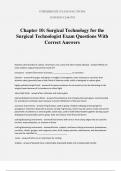©THEBRIGHT EXAM SOLUTIONS
11/05/2024 12:06 PM
Chapter 10: Surgical Technology for the
Surgical Technologist Exam Questions With
Correct Answers
Stainless steel (combo of carbon, chromium, iron, and a few other metals {alloys}) - answer✔What are
most modern surgical instruments made of?
resistance - answer✔Chromium increases _________________ to corrosion.
titanium - answer✔stronger and lighter in weight; nonmagnetic; more resistant to corrosion than
stainless steel; generally have a blue finish of titanium oxide, which is designed to reduce glare
highly polished, bright finish - answer✔increases resistance to corrosion but can be distracting to the
surgical team because of its tendency to reflect light
satin (dull) finish - answer✔less reflective and reduce glare
ebonized (black chromium) finish - answer✔nonreflective and virtually eliminates glare; recommended
for procedures involving a laser because it prevent deflection of the laser beam
accessory instruments - answer✔ring forceps, used to grasp a folded radiopaque 4x4 sponge for
sponging or retraction deep with a wound; curved ring forceps, which may be used to create tunnels for
placement of catheters or arterial grafts; towel clips, used to hold folded towels together during square-
draping and occasionally used to grasp, hold, and reduce small fractured bones
cutting/dissecting instruments - answer✔instruments with one or more sharp edges that are used for
incision, sharp dissection, or excision of tissue
cutting/dissecting instruments - answer✔knives, scalpels, and bone-cutting instruments (osteotomes,
currettes, chisels, gouges, and rongeurs); saws, drills, biopsy punches, adenotomes, and dermatomes
may also be classified as ___________________________
-tome - answer✔refers to an instrument for cutting
scalpels - answer✔typically have a detachable disposable blade and nondisposable handle
, ©THEBRIGHT EXAM SOLUTIONS
11/05/2024 12:06 PM
knife - answer✔have a nondisposable handle and blade as a single unit
safety scalpel - answer✔single-use, disposable knife blades that include a safety shield; may include a
disposable or nondisposable knife handle depending upon the manufacturer
scalpel handle sizes - answer✔#3, #4, #7, and #9
#3 and #4 - answer✔standard handles are 5 inches in length; also available as a long handle
other types of knife handles - answer✔miniature blade handle with chuck (device used to tighten the
blade onto the handle), used for procedures that require very small incisions, such as eye procedures;
Beaver handle, which is specifically designed to hold the small Beaver blades
disposable blades - answer✔made from carbon steel and slide into a groove on the end of the scalpel
handle, although some scalpels handles have a locking mechanism instead of a groove for easy loading;
must be loaded onto and removed from the handle with an instrument, typically a needle holder
blades - answer✔#10, #11, #12, and #15 fit #3, #7, and #9 handles;
#20-#25 fit a #4 handle
#69 - answer✔What is the most frequently used Beaver blade?
#10 (typically loaded onto the #3 handle) - answer✔What is the most frequently used blade?
#11, #12, #15 - answer✔The _____, _____, and _____ blades are usually loaded on the #7 handle.
#15 - answer✔The _____ blade is frequently used with the #3 handle for superficial procedures
requiring a small incision, such as plastic or hand procedures.
#12 - answer✔The _____ blade is used almost exclusively for tonsillectomy.
#20 - answer✔The _____ blade is occasionally used for long and deep abdominal incisions.
types of scissors - answer✔tissue, suture, wire, and bandage/dressing
tissue scissors - answer✔may be of heavy construction for tough tissue, medium construction for tissue
that is neither tough nor delicate, or light constructions for thin, friable tissue; tips may be pointed or
blunt; blades may be straight or curved and available in different lengths and degrees of blade curves
tungsten carbide blades - answer✔these blades are stronger and harder, maintaining their sharpness for
longer than stainless steel; have gold ring handles to distinguish them from conventional instruments
Curved Mayo - answer✔__________________________ scissors are often the choice for heavy tissue.
Curved Metzenbaum - answer✔__________________________ scissors are used for medium to fine
tissue.
, ©THEBRIGHT EXAM SOLUTIONS
11/05/2024 12:06 PM
curved iris, Jamison, Westcott, Stephen's tenotomy, Potts-Smith - answer✔Delicate tissue is frequently
dissected with __________________, __________________, ___________________,
____________________, or _____________________ scissors.
Straight Mayo - answer✔__________________________ scissor are always used to cut suture and are
rarely used to cut tissue.
straight iris, curved Metzenbaum - answer✔Other scissors used for cutting suture include
_____________________ scissors, frequently used to cut fine sutures during ophthalmic or plastic
procedures, and _________________________ scissors, preferred by some cardiovascular surgeons for
cutting polypropylene suture.
Potts-Smith scissors - answer✔for incisions into ducts, veins, or arteries
Jorgenson scissors - answer✔for hysterectomy
Cushing scissors - answer✔for dural incision
Castroviejo scissors - answer✔scissors that are used for microsurgery
strabismus, iris, and corneal scissors - answer✔for eye procedures
grasping/holding instruments - answer✔designed to manipulate tissue to facilitate dissection or suturing
or to reduce and stabilize fractured bone during internal fixation; may or may not have a ratcheted
locking mechanism
thumb forceps - answer✔also referred to as pick-ups; do not have ratchets and are constructed with a
flattened spring handle; are usually used in the nondominant hand to grasp and hold tissue when
suturing or dissecting
Toothed - answer✔_____________________ forceps are most often used on skin, fascia, and other
heavy tissue.
Smooth, serrated - answer✔_____________ and _______________ forceps are used on more delicate
structures, such as vascular, nervous, or bowel tissues.
examples of thumb forceps - answer✔Adson (with and without teeth), Ferris-Smith, DeBakey, Brown,
Russian, Gerald (with and without teeth), and Cushing bayonet forceps (with and without teeth)
ratcheted grasping/holding instruments - answer✔Allis, Babcock, Kocher (Ochsner)
bone-holding clamps - answer✔typically ratcheted and are designed to hold a bone in place for eventual
pinning or plating; examples include Lane, Kern, Lowman, and Lewin
clamping/occluding instruments - answer✔designed to occlude or constrict tissue and are constructed
with opposing ring handles for fingers, ratchets located just below the ringed handles to lock the
instrument in place, and two shanks that connect the ringed handles to the box lock, or hinge joint of




